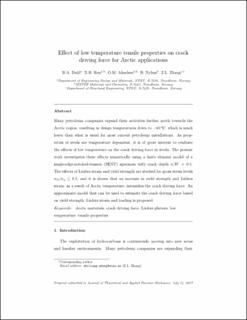| dc.contributor.author | Dahl, Bjørn Augdal | |
| dc.contributor.author | Ren, Xiaobo | |
| dc.contributor.author | Akselsen, Odd Magne | |
| dc.contributor.author | Nyhus, Bård | |
| dc.contributor.author | Zhang, Zhiliang | |
| dc.date.accessioned | 2020-12-22T07:50:09Z | |
| dc.date.available | 2020-12-22T07:50:09Z | |
| dc.date.created | 2017-10-18T09:42:14Z | |
| dc.date.issued | 2017 | |
| dc.identifier.citation | Theoretical and applied fracture mechanics (Print). 2017, 88-96. | en_US |
| dc.identifier.issn | 0167-8442 | |
| dc.identifier.uri | https://hdl.handle.net/11250/2720686 | |
| dc.description.abstract | Many petroleum companies expand their activities further north towards the Arctic region, resulting in design temperatures down to −60 °C, which is much lower than what is usual for most current petroleum installations. As properties of steels are temperature dependent, it is of great interest to evaluate the effects of low temperature on the crack driving force in steels. The present work investigates these effects numerically using a finite element model of a single-edge-notched-tension (SENT) specimen with crack depth (a/W = 0.5). The effects of Lüders strain and yield strength are studied for gross stress levels (σ_G/ σ_y ≤ 0.5), and it is shown that an increase in yield strength and Lüders strain, as a result of Arctic temperature, intensifies the crack driving force. An approximate model that can be used to estimate the crack driving force based on yield strength, Lüders strain and loading is proposed. | en_US |
| dc.language.iso | eng | en_US |
| dc.publisher | Elsevier | en_US |
| dc.rights | Attribution-NonCommercial-NoDerivatives 4.0 Internasjonal | * |
| dc.rights.uri | http://creativecommons.org/licenses/by-nc-nd/4.0/deed.no | * |
| dc.subject | Tensile properties | en_US |
| dc.subject | Low temperature | en_US |
| dc.subject | Lüders plateau | en_US |
| dc.subject | Crack driving force | en_US |
| dc.subject | Arctic materials | en_US |
| dc.title | Effect of low temperature tensile properties on crack driving force for Arctic applications | en_US |
| dc.type | Peer reviewed | en_US |
| dc.type | Journal article | en_US |
| dc.description.version | acceptedVersion | en_US |
| dc.rights.holder | © 2017 Elsevier Ltd. All rights reserved. This is the authors' accepted and refereed manuscript to the article. | en_US |
| dc.source.pagenumber | 88-96 | en_US |
| dc.source.volume | 93 | en_US |
| dc.source.journal | Theoretical and applied fracture mechanics (Print) | en_US |
| dc.identifier.doi | 10.1016/j.tafmec.2017.07.006 | |
| dc.identifier.cristin | 1505426 | |
| dc.relation.project | Norges forskningsråd: 228513 | en_US |
| cristin.unitcode | 7401,80,6,5 | |
| cristin.unitname | Materialers integritet og sveising | |
| cristin.ispublished | true | |
| cristin.fulltext | postprint | |
| cristin.qualitycode | 1 | |

